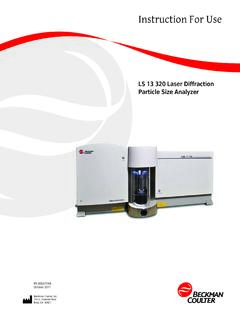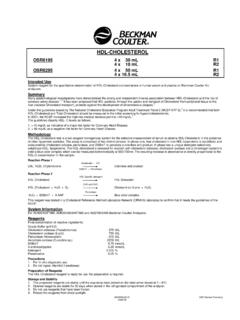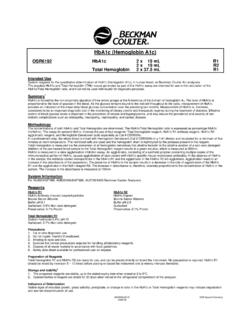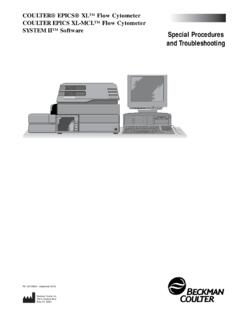Transcription of CREATININE - Beckman Coulter
1 CREATININE . OSR6178 4 x 51 mL R1. 4 x 51 mL R2. OSR6678* 4 x 150 mL R1. 4 x 150 mL R2. Intended Use System reagent for the quantitative determination of CREATININE in human serum and urine on Beckman Coulter AU analyzers. * CREATININE reagent OSR6678 for use on the AU2700/5400 system only. Summary Measurements of CREATININE are used in the diagnosis and treatment of renal disease. Serum CREATININE measurements prove useful in evaluation of kidney glomerular function and in monitoring renal dialysis. However, the serum level is not sensitive to early renal damage and responds more slowly than blood urea nitrogen (BUN) to hemodialysis during treatment of renal failure. Both serum CREATININE and BUN are used to differentiate prerenal and postrenal (obstructive) azotemia. An increase in serum BUN without concomitant increase of serum CREATININE is key to identifying 1. prerenal azotemia. With postrenal azotemia, both serum BUN and CREATININE rise, but the rise is disproportionately greater for BUN.
2 Serum CREATININE varies with the subject's age, body weight, and sex. It is sometimes low in subjects with relatively small muscle mass, cachetic patients, amputees, and in older persons. A serum CREATININE level that would usually be considered normal does not rule out the presence of impaired renal function. Methodology 2. This CREATININE procedure is a kinetic modification of the Jaffe procedure, in which CREATININE reacts with picric acid at alkaline pH to form a yellow- orange complex. However, this reaction is not completely specific for CREATININE since other reducing substances such as glucose, pyruvate, ascorbic 3 4. acid, and acetoacetates will react with picrate to form a similar color. Fabiny and Ertingshausen found that alkaline CREATININE picrate reaches 5. maximum color development at a different rate than pseudo- CREATININE material. Cook utilized different reaction rates of alkaline picrate positive substances to obtain greater specificity with the Jaffe reaction.
3 The rate of change in absorbance at 520/800nm is proportional to the CREATININE concentration in the sample. CREATININE + Alkaline Picrate Yellow-Orange Complex System Information e e For AU400/400 /480, AU600/640/640 /680 and AU2700/5400 Beckman Coulter Analyzers. Reagents Final concentration of reactive ingredients: Sodium hydroxide 120 mmol/L. Picric acid mmol/L. Also contains preservatives Precautions 1. For in vitro diagnostic use. Do not ingest. 2. R1 is corrosive and causes burns. Do not pipette by mouth. Avoid contact with eyes, skin or clothing. In case of contact, immediately rinse affected area with plenty of water for 15 minutes. Obtain medical attention immediately for eye contact or ingestion. Do not induce vomiting. 3. R2 is POISON. Do not pipette by mouth. In case of external contact, immediately flush affected area with plenty of water for 15 minutes. Obtain medical attention immediately for eye contact or ingestion. 4. R2 contains picric acid. Dry picric acid explodes when rapidly heated or subjected to percussion.
4 Dilute any spills with water and wipe up immediately. Preparation of Reagents For OSR6178, the CREATININE reagent is ready for use. No preparation is required. For OSR6678, insert the pipe supplied into the 180 mL reagent vial before use on the analyzer. Care must be taken when handling the pipe to avoid contamination. The pipe is for single use only. Storage and Stability 1. The unopened reagents are stable until the expiration date printed on the label when stored at 2 8 C. 2. Opened reagents are stable for 7 days when stored in the refrigerated compartment of the analyzer. 3. R1 is light sensitive. Store in the dark before placing on the instrument. Indications of Deterioration Visible signs of microbial growth, turbidity, precipitate, or any change in color in the CREATININE reagent may indicate degradation and warrant discontinuance of use. Specimen Collection and Preparation Serum or heparinized samples free from hemolysis are the recommended specimens and should be separated from the red cells as soon as possible.
5 Urine specimens should be collected into a clean, leakproof container. If urine must be collected with a preservative for other analytes, 6. 6N HCL or Boric acid can be used. Sample Storage and Stability 8. Serum CREATININE is stable for 7 days at 2 8 C and indefinitely when frozen ( -20 C ). CREATININE in urine is stable for 2 days at room temperature 7. (20 25 C) and for 6 days at 4 8 C. OSR General Chemistry 2010-09. CREATININE Interfering Substances 9. Results of studies show that the following substances interfere with this CREATININE procedure. The criteria for no significant interference is recovery within 10% of the initial value. Bilirubin: No significant interference up to 20 mg/dL Bilirubin Hemolysis: No significant interference up to 500 mg/dL Hemolysate lipemia : No significant interference up to 700 mg/dL Intralipid*. Protein: Interference less than 20% between 3 and 12g/dL Protein *Intralipid, manufactured by KabiVitrium Inc., is a 20% IV fat emulsion used to emulate extremely turbid samples.
6 The information presented is based on results from Beckman Coulter studies and is current at the date of publication. Beckman Coulter Inc. makes no representation about the completeness or accuracy of results generated by future studies. For further information on interfering substances, refer 10. to Young for a compilation of reported interference with this test. Procedure A complete list of test parameters and operational procedure can be found in the User's Guide appropriate to the analyzer. Materials Provided CREATININE Reagent Pipe (one per each 180 mL vial). Materials Required But Not Provided Chemistry Calibrator (Cat # DR0070). Urine CREATININE Calibrator (Cat # DR0091). Stability of Final Reaction Mixture The Beckman Coulter AU analyzer automatically computes every determination at the same time interval. Calibration The frequency of calibration is daily. Calibration of this CREATININE procedure for serum determinations is accomplished by use of the Chemistry Calibrator (Cat # DR0070), which is traceable to an isotope dilution mass spectrometry (IDMS) reference method using the National Institutes of Standards and Technology (NIST) Standard Reference Material 967.
7 For the calibration of urine specimens, Urine CREATININE Calibrator (Cat # DR0091) should be used. Recalibration of this test is required when any of these conditions exist: 1. A reagent lot number has changed or there is an observed shift in control values. 2. A fresh bottle of reagent is used for testing. 3. Major preventative maintenance was performed on the analyzer or critical part was replaced. Quality Control During operation of the Beckman Coulter AU analyzer at least two levels of an appropriate quality control material should be tested a minimum of once a day. In addition, controls should be performed after calibration, with each new lot of reagent, and after specific maintenance or troubleshooting steps described in the appropriate User's Guide. Quality control testing should be performed in accordance with regulatory requirements and each laboratory's standard procedure. Appropriate qualified urine controls should be established and utilized during urine analysis.
8 Results Automatically printed out for each sample in mg/dL at 37 C. Dynamic Range The CREATININE procedure is linear from to mg/dL for serum determinations and 1 - 300 mg/dL for urine determinations. Samples exceeding the upper limit of linearity should be diluted and repeated. The sample may be diluted, repeated and multiplied by the dilution factor automatically by utilizing the AUTO REPEAT RUN. Expected Values 11 1. Serum Urine Male - mg/dL 14 - 26 mg/kg/24 hours Female - mg/dL 11 - 20 mg/kg/24 hours Beckman Coulter Reference - mg/dL. 13. Range Expected values may vary with age, sex, diet and geographical location. Each laboratory should determine its own expected values as dictated by good laboratory practice. Specific Performance Characteristics The following data was obtained using the CREATININE Reagent on Beckman Coulter AU analyzers according to established procedures. Results obtained in individual laboratories may differ. 14. Precision 12. Estimates of precision, based on CLSI recommendations, are consistent with typical performance.
9 The within run precision for serum samples is less than 3% CV and total precision is less than 6% CV. Assays of control sera were carried out and the data reduced following CLSI guidelines above. Serum N = 100 Within run Total Mean, mg/dL SD CV% SD CV%. OSR General Chemistry 2010-09. CREATININE Urine N = 100 Within run Total Mean, mg/dL SD CV% SD CV%. 14. Method Comparison Serum Patient samples were used to compare this CREATININE Reagent. The table below demonstrates representative performance on the AU analyzers. Y Method AU640. X Method AU600. Slope Intercept Correlation Coeff. (r) No. of Samples (n) 175. Range (mg/dL) Urine Patient samples were used to compare this CREATININE Reagent. The table below demonstrates representative performance on the AU analyzers. e Y Method AU640/640. X Method AU600. Slope Intercept Correlation Coeff. (r) No. of Samples (n) 176. Range (mg/dL) 11-281. Sensitivity Typical change in absorbance for 1 mg/dL of CREATININE is mAbsorbance. References 1.
10 Tietz, (ed), Textbook of Clinical Chemistry, Saunders, 1986. 2. Jaffe, Physiol Chem, 10: 391,1886. 3. Soldin, et al., Clin Biochem, 11: 82, 1987. 4. Fabiny, and Ertingshausen, G., Clin Chem, 17: 696, 1971. 5. Cook, , Clin Chem Acta, 32: 485, 1971. 6. CLSI/NCCLS. Urinalysis and Collection, Transporatation, and Preservation of Urine Specimens; Approved Guideline. CLSI/NCCLS Document GP16- A2, 2nd ed. Pennsylvania. 7. Ehret W, Heil W, Schmitt Y, Topfer G, Wisser H, Zawta B, et al. Use of anticoagulants in diagnostic laboratory investigations and stability of blood, plasma and serum samples. WHO/DIL/ :22pp. 8. Tietz, , Fundamentals of Clinical Chemistry, 3rd Edition Saunders, 1987. 9. CLSI/NCCLS, Interference Testing in Clinical Chemistry EP7-A, 2002. 10. Young, , Effects of Drugs on Clinical Laboratory Tests, 5th Edition, AACC Press, 2000. 11. Burtis, and Ashwood, , eds., Tietz Textbook of Clinical Chemistry, 2nd Edition, AACC Press, 1990. 12. CLSI/NCCLS Evaluation Protocol, EP5-A, 1999.



